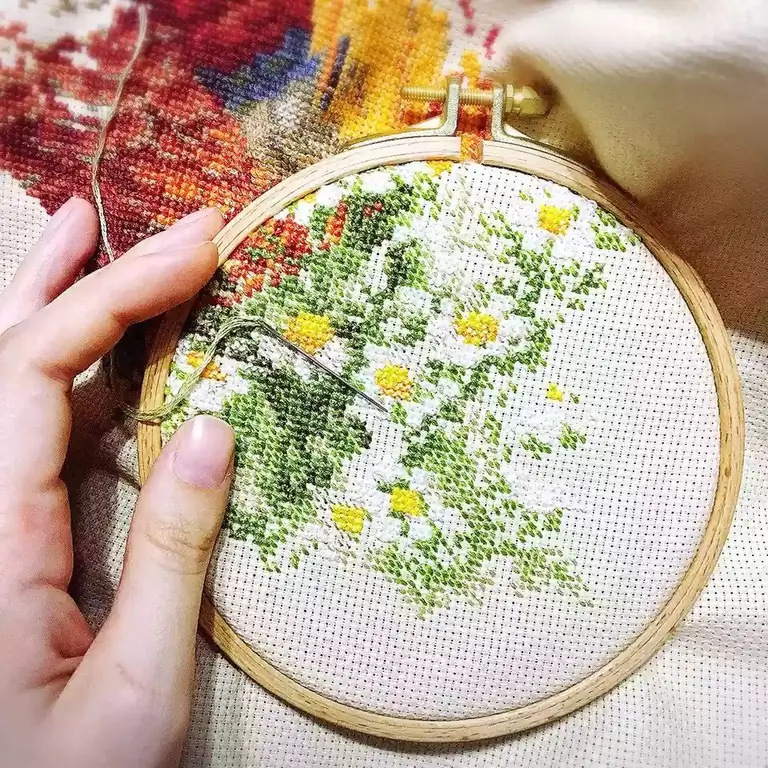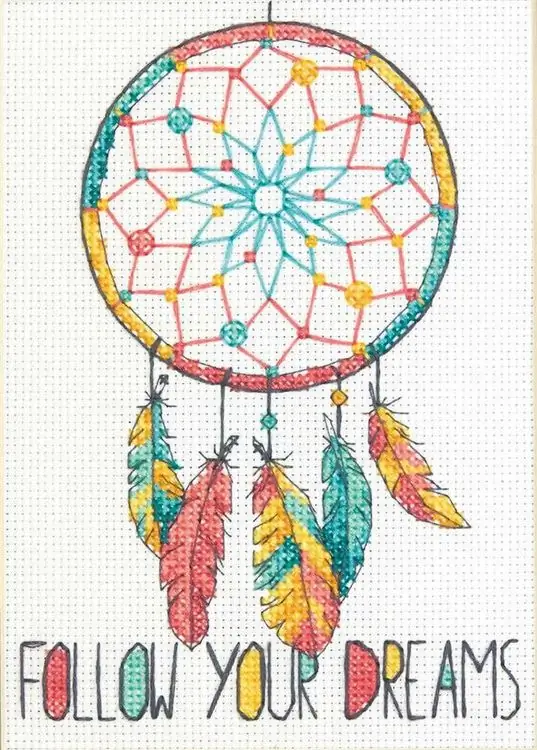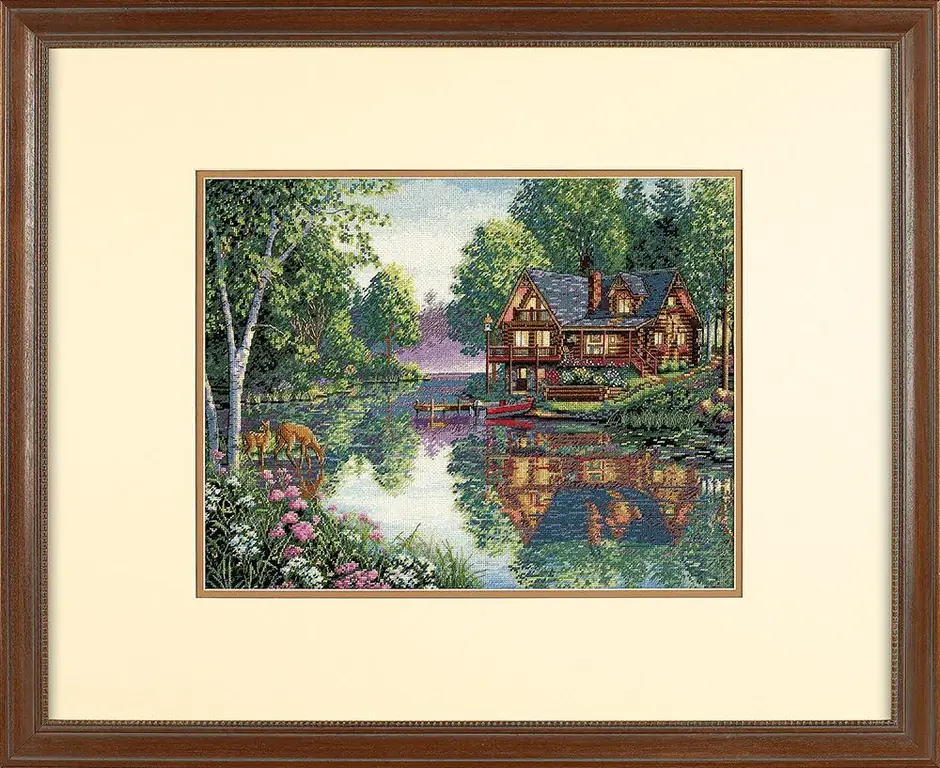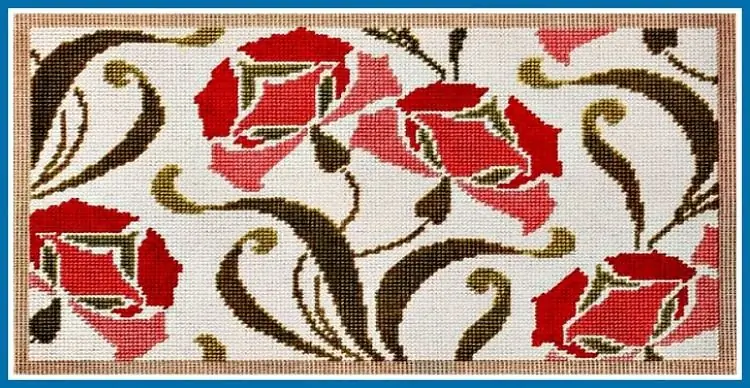
Inhaltsverzeichnis:
- Autor Sierra Becker [email protected].
- Public 2024-02-26 04:45.
- Zuletzt bearbeitet 2025-01-22 22:11.
Jede Stickerin weiß, wie mühsam und langwierig ihre Arbeit sein kann, besonders wenn es um große Bilder, Kissen oder Wandteppiche geht. Es ist äußerst enttäuschend, wenn die Arbeit zu Ende geht und deutlich wird, dass der verbleibende Freiraum auf der Leinwand schmerzlich fehlt. Viel Zeit und Mühe verschwendet.
In diesem Artikel erklären wir Ihnen, wie Sie die Leinwand für Kreuzstiche richtig berechnen, und basierend auf diesen Empfehlungen werden Sie von Ihrer Handarbeit nicht enttäuscht sein.

Was Sie über die Vorbereitung zum Sticken wissen müssen?
Der Beginn jedes neuen Stickprojekts sollte gründlich vorbereitet werden. Die Vorbereitung umfasst den Kauf von Fäden in den erforderlichen Farben, die Auswahl der Stickgrundlage, Zubehör und die Organisation des Arbeitsbereichs. Wenn etwas versäumt wird, kann die Arbeit verdorben werden, und der Prozess wird bringenEnttäuschung.
Nehmen wir also an, dass die Garnpalette fertig ist, der Rahmen, die Nadelstange und die Schere ebenfalls auf den Arbeitsbeginn warten und sich eine der Hauptfragen stellt - die Auswahl der Leinwand und der Größenauswahl.
Einige Nadelfrauen beginnen mit einem großen Rand auf Leinwand zu sticken und messen im Voraus ein solches Stück Stoff, das am Ende der Arbeit abgeschnitten werden muss. Dies ist umständlich und nicht wirtschaftlich, und es ist besser, die erforderliche Leinwandmenge klar und genau abzumessen.
Wie berechne ich die Leinwandgröße?
Die Größe der Stickerei auf der Leinwand sowie der Leinwand selbst wird durch ihr Hauptmerkmal bestimmt - die Anzahl. Count ist die Anzahl der Kreuze, die in einem Zoll (das sind 2,54 Zentimeter) gestickt werden können. Dieser Parameter gibt auch die Nummer der Leinwand an. Wenn auf der Verpackung beispielsweise "Aida Nr. 14" steht, bedeutet dies, dass 14 auf diese Leinwand gestickte Kreuze einen Zoll ausmachen. Dementsprechend werden die Kreuze umso kleiner, je größer der numerische Wert der Zählung ist, und das Muster wird dünner.
Erstellen wir der Einfachheit halber eine kurze Tabelle zum Zählen von Kreuzen in 10-Zentimeter-Schritten.
| Aida 11 | 43 cr/10cm |
| Aida 14 | 55 Cr./10cm |
| Aida 16 | 63 Cr./10cm |
| Aida 18 | 71 Cr./10cm |
| Aida 22 | 87 Cr./10cm |
Sehen Sie sich als nächstes das Stickmuster genau an - es zeigt an, wie viele Kreuze sich auf jeder Seite befinden, horizontal und vertikal. Basierend auf der Tatsache, dass wir die Anzahl der Leinwand und die Gesamtzahl der Kreuze kennen, wird es nicht schwierig sein, die Leinwand zu berechnenfür Kreuzstich in Zentimetern.
Als nächstes rechnen wir nach dem Prinzip einer einfachen Gleichung. Nehmen wir zum Beispiel die Leinwand Aida 16 - 63 Kreuze um 10 Zentimeter. Nehmen wir 100 Kreuze als X Zentimeter: X \u003d 100 x 10/63 \u003d 16 Zentimeter.
Fügen Sie auf jeder Seite etwa 5-7 Zentimeter hinzu, denn nach Abschluss der Arbeit müssen Sie sie dekorieren, außerdem wird es ohne Zugabe schwierig sein, die Leinwand in den Rahmen zu stecken.
Insgesamt, wenn die Größe der fertigen Arbeit 100 mal 100 Kreuze betragen soll, dann sollte der Leinwandzuschnitt etwa 25 mal 25 Zentimeter messen.

Empfehlungen für Näherinnen
Wenn anstelle von "Aida" ein einheitliches Gewebe oder Leinen verwendet wird, muss auch auf die Nummerierung geachtet werden - der Stoff wird analog zur Leinwand nummeriert.
Es gibt spezielle Programme und Online-Dienste, die Ihnen helfen können, die Leinwand für Kreuzstiche zu berechnen.
Vor der Arbeit ist es besser, die Stoffkante zu versäubern, damit die Fäden nicht herausfallen - mit einer kleinen Zugabe kann die aufgetrennte Kante zu Unannehmlichkeiten bei der Gest altung der Arbeit führen.
Beim Sticken aus einem fertigen Set lassen sich Probleme mit der Größe der Leinwand meist vermeiden, aber für ein gleichmäßiges Bild ist es besser, mit dem Sticken von der Mitte aus zu beginnen.
Empfohlen:
Bulgarischer Kreuzstich: Technik, Empfehlungen für Anfänger

Verschiedene Arten von Handarbeiten sind in Osteuropa weit verbreitet, aber eine der schönsten und ältesten Arten ist die bulgarische Kreuzstichstickerei. Die Sticktechnik besteht darin, ein gerades und einfaches Kreuz zu kreuzen, das letztendlich einer Schneeflocke ähnelt. Die Farbigkeit und Originalität der Stickerei brachte ihr Popularität und Liebe zu Nadelfrauen. Wie wird das bulgarische Kreuz hergestellt und was ist das Geheimnis der Technik?
Kreuzstich-Gänseblümchen: Schemata und Tipps für Anfänger

Gezählter Kreuzstich gibt es schon seit Jahrhunderten und ist immer noch eine der einfachsten Möglichkeiten, um mit dieser Art von Handarbeiten anzufangen. Mit diesen einfachen Fähigkeiten können Sie echte Gemälde erstellen, ohne ein Künstler zu sein. Wenn Sie zum ersten Mal in die Welt des Kreuzstichs einsteigen, müssen Sie die Grundlagen kennen. Du kannst sie sehr schnell lernen
Zeichen im Kreuzstich: Was sind sie, ihre Bedeutung und Interpretation

Seit der Antike diente die Stickerei nicht nur der Verzierung von Kleidung und Haush altsgegenständen, sondern erfüllte auch eine magische Funktion. Spezielle Ornamente und Muster, die es schon vor dem Erscheinen der ersten Schriftsprache gab, werden seit Jahrhunderten zur Übermittlung von Informationen verwendet. Sie ersetzten die Texte, und nachdem sie die Zeichen entziffert hatten, war es möglich, Beschwörungsformeln, Lieder und ganze Märchen zu lesen
Faszinierende Handarbeiten - Kreuzstich: Schemata von Häusern

Viele Nadelfrauen können sich eines Bildes rühmen, das mit ihren eigenen Händen mit einem Kreuz bestickt ist. Sticken ist auch für Menschen attraktiv, die selbst keine Lust auf Kreativität haben. Es gibt viele Plots zum Sticken. Sticken ist schließlich eine Kunst. Vielleicht ist eines der beliebtesten Motive das Haus. Große alte Herrenhäuser, Landhäuser, ländliche Hütten, märchenhafte Schlösser und kleine stilisierte Bilder – Ideen zur Inspiration gibt es viele
Vintage Kreuzstich: Schemata, Bedeutung und Traditionen

Stickerei entstand vor mehreren Jahrhunderten in Russland. Bisher ist diese Art von Kreativität bei Nadelfrauen weit verbreitet. Viele Schemata und Techniken der Stickerei haben bis heute überlebt. Heute ist Stickerei wieder in Mode. Sie dekoriert Kleidung und Accessoires. Darüber hinaus werden sowohl moderne als auch antike Motive gestickt
